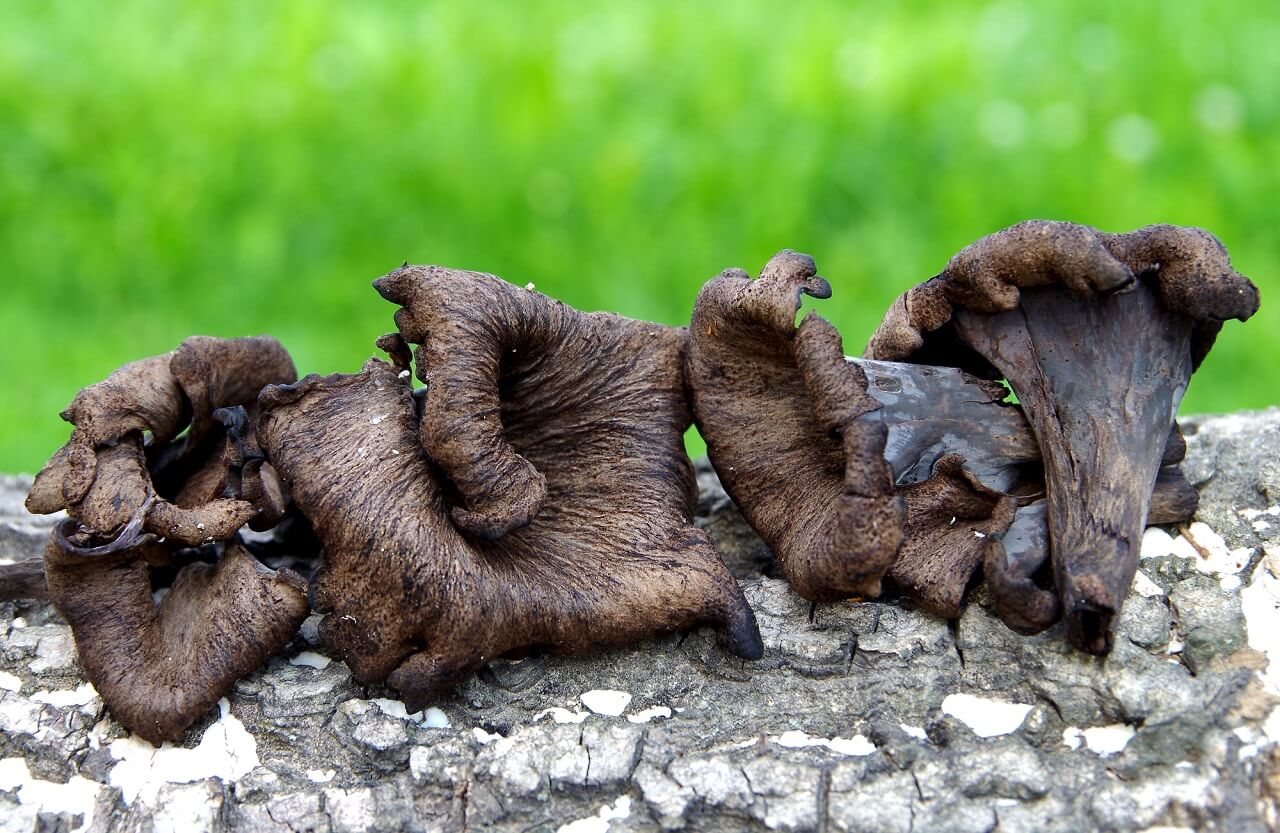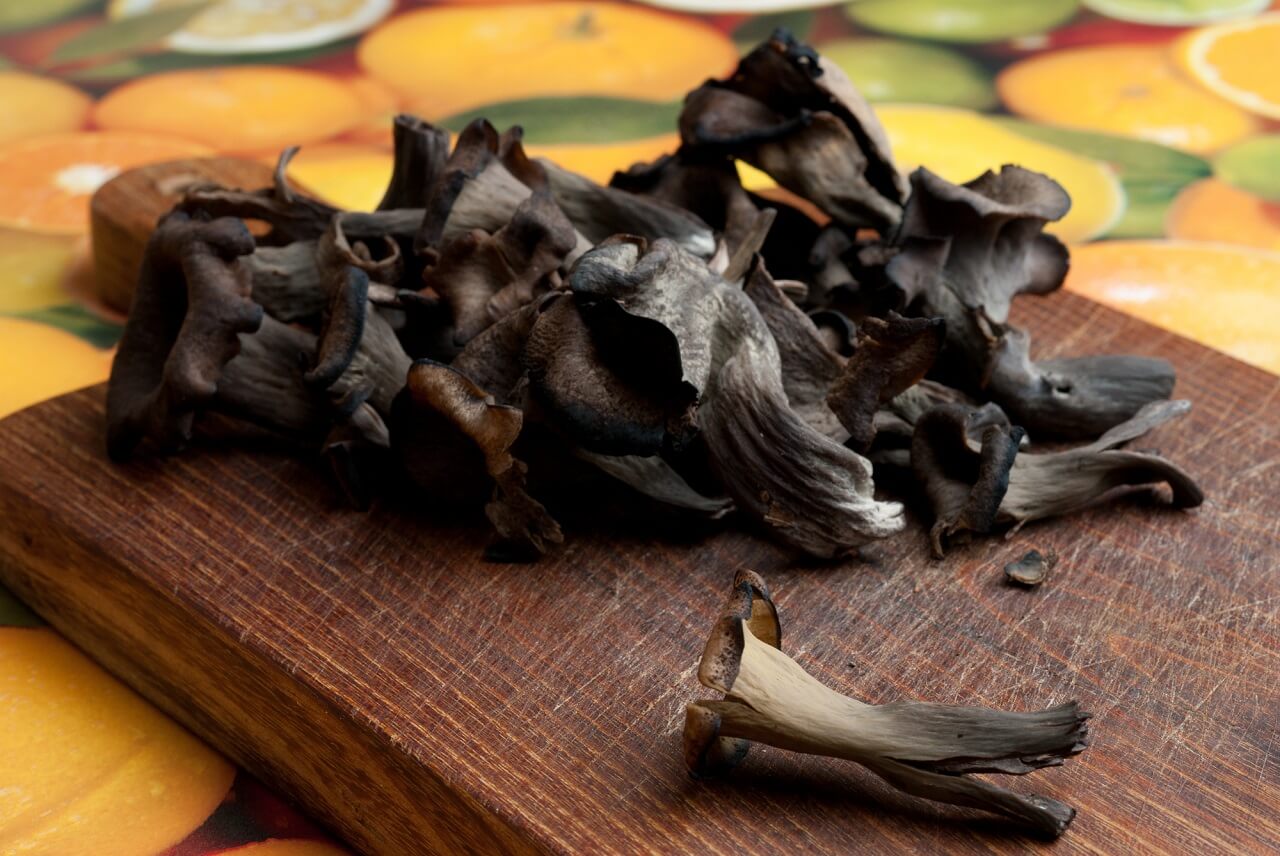Black trumpets are considered one of the tastiest mushrooms in the world. If you’re wondering how to cook black trumpet mushrooms, keep reading. In this article, we’ll discuss the taste and texture of these mushrooms as well as some different ways to prepare them.
What You'll Learn Today
Are Black Trumpet Mushrooms Edible?

Black trumpets are edible and delicious; in fact, they are highly sought after among chefs and mushroom enthusiasts alike. These ugly but tasty shrooms are a favorite ingredient in many gourmet recipes.
Black trumpets are difficult to cultivate and can be a challenge to find in the wild. Like morel mushrooms, they only appear for a few weeks out of the year, and you have to know where to look for them.
The good news is, once you find where they grow, you can go back for more season after season. Black trumpets tend to grow in the same areas as long as ground and moisture conditions are conducive to producing them.
What’s more, black trumpets have no poisonous look-alikes in the wild, which makes them a great mushroom for beginning foragers. They may be difficult to spot on a floor of forest debris, but once you see them, they are easy to recognize and identify.
Can You Eat Black Trumpet Mushrooms Raw?
Technically, you can eat black trumpets any way you want to prepare them–raw, dried, sauteed, baked, fried, or steamed.
If you want to eat them raw, it’s best to choose young, tender mushrooms. The older they get, the tougher and more fibrous they become.
Older black trumpets are best dried or cooked, but if you have an abundance of young, fresh mushrooms, it would be a shame not to take advantage of their delicate flavor and texture by trying them raw.
What Do Black Trumpet Mushrooms Taste Like?
By now, you may be intrigued by the thought of an elusive, highly flavorful wild mushroom. You may be thinking of going out and hunting for some in your area, but you have one concern:
What if you don’t like the taste?
Won’t that be a lot of wasted effort to forage, clean, and cook the mushrooms? Not to mention a waste of good mushrooms if you can’t stand the taste.
The truth is, black trumpets have a flavor that’s very hard to describe. Some have described the flavor as rich and smokey, nutty, deep and earthy, or mildly mushroom-y.
They don’t taste much like they smell. Black trumpets have a surprisingly sweet, fruity sort of aroma similar to the chanterelle mushroom.
Speaking of which, black trumpets are sometimes called black chanterelles due to their similarity in flavor and aroma.
Some foragers have also noted that black trumpets taste similar to truffles.
So, if you like mushrooms in general, especially chanterelles and truffles, you will probably like the taste of black trumpets. Even if you don’t typically care for mushrooms or have never tried them, you may be won over by the light, mild flavor of black trumpets.
If you’re not confident that you’ll like them, then don’t pick too many at first. Start out with just enough to sample raw, throw on the dehydrator, or add to your favorite recipe.
If you don’t like them, then you don’t have to feel bad about throwing away a large harvest. And if you do like them–well, you now know where to find more!
How to Cook Black Trumpet Mushrooms

As noted above, you can prepare black trumpets almost any way you want to. However, there are a few things to consider.
Keep it Simple
Black trumpets are flavorful mushrooms. There’s no need to drown out their natural flavors by dousing them with too much oil, butter, or seasonings.
You can deep fry them if you want, but there’s really no need. Battering and frying these mushrooms will give them the usual fried food taste and will overwhelm their own distinctive flavor.
Always Clean Them First
Some foragers don’t believe in washing mushrooms because they act like a sponge, absorbing quite a bit of the wash water. But others believe that having slightly more hydrated shrooms is better than having dirt as one of the “seasonings.”
The best way to clean black trumpets is to use a dry brush or cloth to remove as much of the dirt as possible, then quickly dunk or rinse them under water. If you are able to remove most of the dirt first, you won’t have to leave them under water as long, and they will absorb less of it.
Pair Them Up
If you want to pair them with other mushrooms, that’s great! Black trumpets go especially well with chanterelles, which taste similar and will add some bright colors to your mushroom dish.
Keep in mind though: strongly-flavored mushrooms may drown out the black trumpet taste. When pairing your black trumpets, it’s best to use other more mild-tasting mushrooms so that all the flavors can blend.
Beware of Overcooking
Black trumpets, like any mushroom, will become slimy and limp if cooked for too long. Young, tender mushrooms cook much more quickly than older, tougher ones, so you’ll need to keep an eye on them as they cook.
Ideally, cooked black trumpets should be soft but not squishy, slimy, mushy. They will still have a pleasant toughness to them, but you will be able to cut them easily with a fork or a knife.
How long should you cook them? That will depend on their size and age, as well as whether you’re using fresh or dried mushrooms.
Most recipes using black trumpets involve a cook time of 20 to 25 minutes. But many of these recipes use dried black trumpets.
For fresh mushrooms, especially if they’re young or small, you can adjust the cook time by as much as half. Generally, you’ll want to cook them for 10 to 15 minutes, but it’s okay to experiment to see how well you like the texture at different cooking stages.
Check out this video of a delicious black trumpet stir-fry recipe using fresh mushrooms:
How to Prepare Dried Black Trumpet Mushrooms
According to the Missouri Department of Conservation, drying black trumpet mushrooms greatly improves their flavor.
To dehydrate black trumpets, make sure they are fully clean and dried. You can drain them on a towel after washing them if you prefer.
Once you’re ready to start, you’re going to need a few items:
- A dehydrator
- A knife
- A cutting board
Using the knife and cutting board, start out by slicing the mushrooms into uniformly sized pieces. Place them evenly on dehydrator trays.
Set the dehydrator’s temperature to anywhere between 125 and 175 degrees Fahrenheit. They will take longer to dry at lower temperatures, but more of the flavor will be preserved.
Dry the mushrooms until they snap between your fingers. This could take anywhere from a few hours to overnight.
Allow them to cool for a few minutes before transferring them to airtight jars.
Alternatively, you can air dry the mushrooms in a sunny location as long as the humidity isn’t too high. Depending on how hot it is, air drying mushrooms may take significantly less time than drying them in a dehydrator.
Dried black trumpets can be stored at room temperature for up to a year.
What to Do With Dried Black Trumpet Mushrooms
Black trumpets are delicious added to savory recipes such as soups, stews, sauces, meat or veggie dishes, and more. They can be substituted for other kinds of mushrooms in recipes.
If you’re using black trumpets whole or in large pieces, you will need to reconstitute them first. Soak them in warm water for 15 to 20 minutes before adding them to the recipe.
You can also grind them into a powder to use as a seasoning. Just sprinkle the powdered mushrooms into any recipe as you would other dry spices.
If you’re feeling ambitious, you could use powdered black trumpet to make homemade pasta, as shown in the following video:
Conclusion
Black trumpet mushrooms are a gourmet edible. These tasty fungi will add an earthy richness to any savory dish.
Can you share some simple recipes with black trumpet mushrooms?